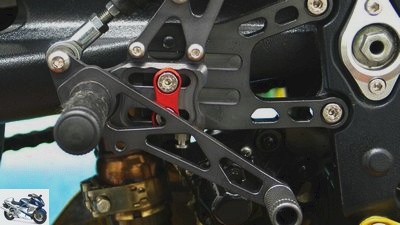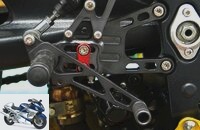Table of contents
- PS reader question about ergonomics on the motorcycle Sits, fits, wobbles and has air
- PS answer
- Adjust the handlebar, throttle grip and lever correctly
- Find the optimal position for the brake pedal and gear lever
- Do not restrict your view to the front

jkuenstle.de
Sports & scene
Motorsport
PS reader question about ergonomics on the motorcycle
PS reader question about ergonomics on the motorcycle
Sits, fits, wobbles and has air
Content of
How can you find out whether the levers fit correctly, the handlebar ends are positioned correctly and the notches are correctly adjusted? Motorcycle whisperer Werner “Mini” Koch explains.
Werner Koch
02/09/2016
“Dear PS editorial staff, I got a used one for Christmas Daytona 675 bought and think the motorcycle is great. But I think I could sit on it better. I have now simulated several times in the garage. How do I find out that the levers are right for me, the handlebar ends are correctly positioned (so that I can steer perfectly) and the notches are set correctly for my legs / feet? There are rules of thumb, also for gearshift levers and foot brakes?”
Buy complete article

PS reader question about ergonomics on the motorcycle
Sits, fits, wobbles and has air
2 pages) as PDF
€ 2.00
Buy now
PS answer
The small Daytona 675 in particular requires optimally adjusted levers and fittings due to its compact, front-wheel-oriented and sporty ergonomics. The sitting posture of the 675 is simply too extreme for pure road use, which is why our colleagues at MOTORRAD have equipped their endurance tester with different handlebar stubs. The upward offset makes the bent position more bearable without losing the feel of the front wheel. The range of handlebar stubs with offset or even a stepless angle adjustment is huge, but the tightly cut fairing sets limits. You can’t go more than 20 to 25 millimeters higher without colliding with the cladding dome. Nonetheless, 20 millimeters can decide whether you can relax and get off the box after a day on the country road or whether the chiropractor has to operate on you from the moped. For road use, you should have installed an adjustable footrest system: the higher the handlebar, the further forward the footrest position. This ensures that the driver can better support himself on his legs and thus less weight on the arms.
And one more recommendation: If you don’t mind the look, the so-called stompgrip knee cushions on the tank make braking easier, as you can support yourself with the least amount of force on the knob surface. Especially during long, hard braking, this allows the body weight to be shifted backwards and thus reduces the tendency for the rear wheel to lift off.
Adjust the handlebar, throttle grip and lever correctly
When placing the palms of the hands on the brake and clutch handles, they must form a line with the forearms in a normal sitting position. If not, the tendons run over the angled wrist like a Bowden cable over a kink. For the racetrack, however, it must be taken into account that the clutch lever must also be operated in a lying position when accelerating and that it can therefore be adjusted a little higher. The brake lever, on the other hand, is usually only pulled when the upper body is completely upright, as the wind pressure can be used as an additional delay in this position.
Access to the brake lever must also be right. The brake fingers, two (ring / middle finger) or three (plus index finger), depending on strength and preference, should rest on the end of the brake lever if possible. This is the only way to fully utilize the leverage effect. If the fingers reach too close to the pivot point, braking power and controllability are lost.
The brake pump is often too close to the throttle grip and can be moved inward by loosening the clamping screws. To be on the safe side, after this adjustment it is checked whether the brake lever can be pulled through to the handle without contact. To do this, the brake pistons on the calipers are pushed back slightly into their seat. This can be done by hand with floating panes. If not, the pads are carefully pushed back with a rounded mounting lever. Then the brake lever can be pulled all the way to the rubber grip. It must not collide with other components (throttle cables, switch unit). Our tip: One of the clamping screws on the hand lever is usually marked with an arrow or punch dot. This is first tightened so that the clamp lies flat. The clamping is then activated with the second screw.
Avoid too much play on the throttle grip. The twist grip should move a maximum of one millimeter. More play can increase the load change shock when applying the gas, which is rather hearty on the older Daytona 675. This play can be set with the length adjustment on the opening cable. Then you turn the handlebars to the left and right with the engine running to ensure that the cable is not overstretched and the idle speed is increased in the process.
The rubber grips on the handlebars can be replaced by replacement parts with a soft rubber compound for a secure, full grip. As with good tires, the profile, i.e. the surface structure, plays less of a role than the rubber compound. If the handles are too slippery and therefore have to be gripped vigorously, this leads to fatigue in the forearm muscles in the long run.
Find the optimal position for the brake pedal and gear lever
Because the rear brake also plays an important role in road traffic, keyword wetness or gravel, the height of the brake pedal should be adjusted so that the foot does not have to be lifted to build up brake pressure. Only if the sole is on the pedal with light pressure can this be properly dosed from the first moment. If the pedal is too high, there is also the risk that the brake disc and pads will burn up due to constant, light pressure.
On the opposite side, the shift lever is also adjusted in height so that it can be used for upshifting and downshifting without twisting. With the Daytona, the simple ball heads can be exchanged for high-quality, smooth-running spherical bearings. Depending on the intended use (race track or country road), you have to decide whether the optimal position for changing gears is to be adjusted upwards (accelerating) or downwards (braking). The following applies: trying is better than studying.
Do not restrict your view to the front
If you sit extremely bent over on the motorcycle, and this is the case with the Triumph Daytona 675, you should make sure that the top edge of the helmet does not restrict your view to the front. This is necessary if the line of sight is to go far ahead when cornering, possibly even to go up steeply when driving on passes.
If the helmet is too low, the driver is forced to overstretch the neck strongly backwards. Because this posture is exhausting in the long run, one tries to avoid it. With the result that the line of sight is neglected in the truest sense of the word. The result: lousy line choice, poor turn-in points and multiple incorrect placement of the apex in long curves.
Related articles
-
Photo: fact, cook 20th pictures Cook 1/20 …which we have secured against twisting with an M4 worm screw and a fixing hole. fact 2/20 Only when the boot…
-
PS reader question on motorcycle technology – tire wear on the racetrack
jkuenstle.de 5 pictures markus-jahn.com 1/5 “What is the reason for the flaky, frayed way in which racing tires are destroyed??”, asks us reader Holger…
-
PS reader question about motorcycle technology
jkuenstle.de counselor technology & future PS reader question about motorcycle technology PS reader question about motorcycle technology Beam or banana…
-
PS reader question about motorcycle technology – cleaning the radiator
www.factstudio.de, Joachim Schahl 7th pictures archive 1/7 Picture gallery, technical question: cleaning coolers. Werner Koch 2/7 When the delicate…
-
Bilski counselor workshop Check motorcycle Basic motorcycle check Brief routine before the trip You never have time for some annoyances – unless you take…
-
PS-Technik reader question Mount heat protection on the manifold
Cook counselor technology & future PS-Technik reader question Mount heat protection on the manifold Technology: Mount the heat protection on the manifold…
-
PS reader question about motorcycle technology crash pads
Henniges 7th pictures Wiessmann 1/7 Picture gallery, technology: Are crash pads in makes sense in each case? Katrin Sdun 2/7 These crash pads are not…
-
PS reader question about motorcycle technology – translation for the racetrack
Werner Koch 14th pictures factstudio.de 1/14 How do you find the right translation for the racetrack? factstudio.de 2/14 Quick change transmissions in GP…
-
Ergonomics and correct sitting
Yvonne Hertler 26th pictures MOTORCYCLE 1/26 On the way on alpine passes? That’s how it works! MOTORCYCLE 2/26 Seductive winding curves with risk. The…
-
Braking properly with the motorcycle
Jahn counselor Driving experience & Driving tips Braking properly with the motorcycle Brake properly Braking with and without ABS Motorcycles ride well…